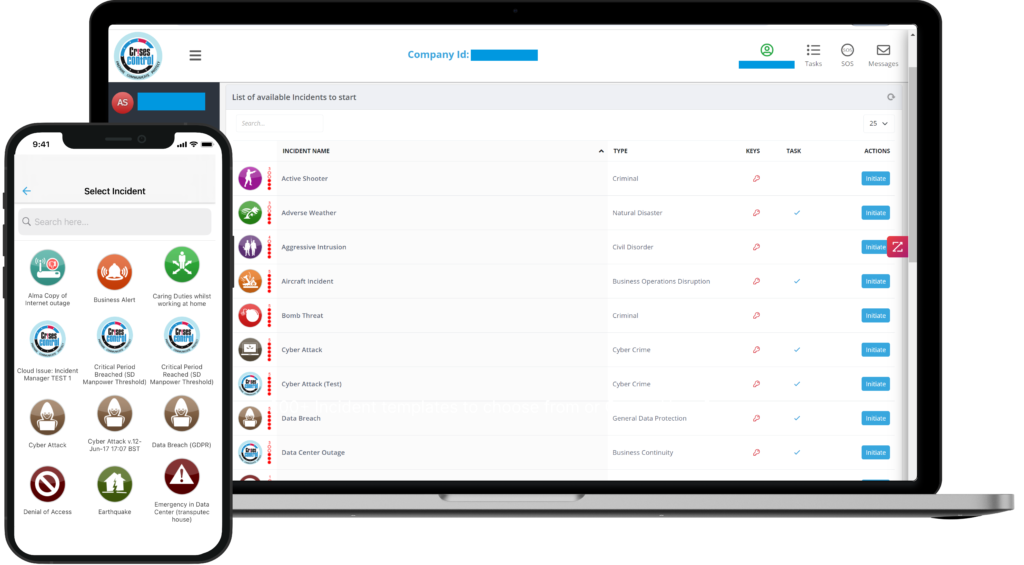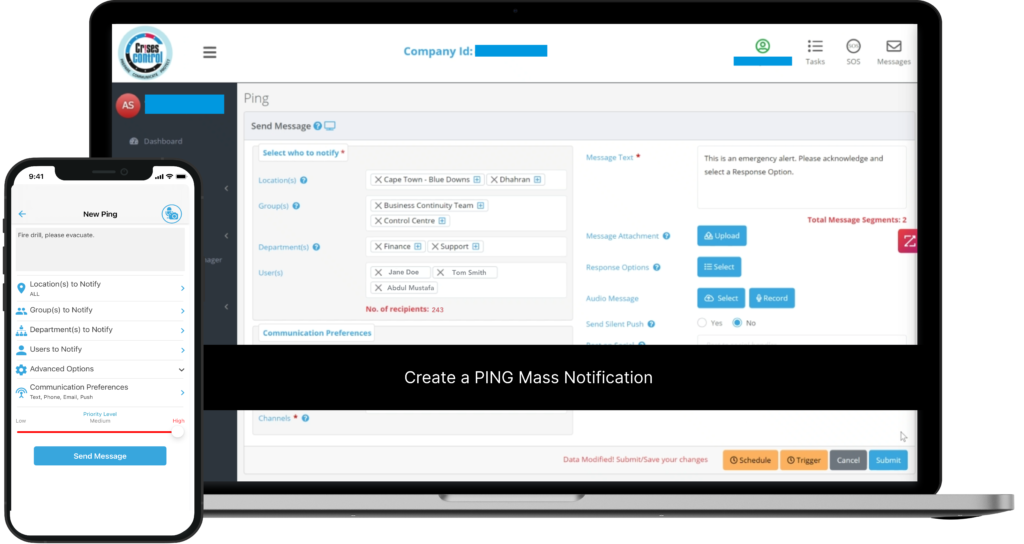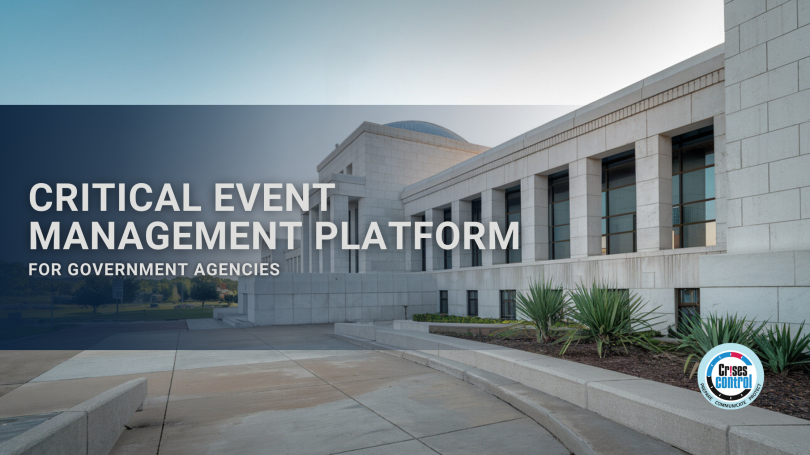Written by Anneri Fourie | Marketing Executive
Government agencies face a variety of challenges—from natural disasters and public health emergencies to civil unrest and cybersecurity threats. The ability to respond swiftly and effectively is no longer optional; it’s essential. This is where critical event management comes into play, offering a structured approach that can turn chaos into order and help safeguard public safety.
In this blog, we will explore how critical event management platforms empower government agencies to handle crises more efficiently. We will delve into key features that enhance decision-making, facilitate communication, and integrate vital data. Most importantly, we’ll discuss how Crises Control can help government agencies streamline their crisis management efforts and stay ahead of disruptions.
Understanding Critical Event Management
Critical event management is a systematic method for identifying, assessing, and responding to significant events that could threaten public safety and operational integrity. It encompasses a range of activities, from planning and preparedness to effective response and recovery. For government agencies, implementing a robust critical event management strategy is essential for managing crises and ensuring the well-being of citizens.
What is a Critical Event Management Platform?
A critical event management platform acts as a central hub that simplifies the processes involved in crisis management. By integrating various functionalities—such as data analysis, communication tools, and decision support systems—these platforms enable agencies to respond promptly and effectively to emergencies.
Key Features of a Critical Event Management Platform
Real-Time Data Integration
In an emergency, access to accurate and timely data is crucial. A critical event management (CEM) platform allows government agencies to collect and aggregate information from multiple sources, including social media, sensors, and emergency reports. This real-time data integration enables agencies to have a comprehensive understanding of the situation, facilitating informed decision-making.
- Example: During a natural disaster, agencies can use real-time data to monitor weather conditions, assess damage, and coordinate rescue efforts. With this information at their fingertips, decision-makers can quickly determine the most effective course of action.
Communication Tools
Effective communication is vital during a crisis. A CEM platform provides a range of communication tools, including alerts, notifications, and messaging systems, to ensure information flows seamlessly between agencies, emergency response coordinators, public safety officers, and the public.
- Example: In the event of a public health crisis, agencies can quickly disseminate essential information, such as safety guidelines and updates on the situation. This timely communication helps build trust with the public and ensures everyone has the information they need to stay safe.
Decision-Making Support
When crises occur, decision-makers require actionable insights to navigate complex scenarios. A CEM platform offers analytical tools that help agencies evaluate different courses of action, assess risks, and predict outcomes. This support enables officials to make well-informed decisions that enhance public safety.
- Example: During a crisis, decision-makers can analyse data to determine the best allocation of resources, ensuring that assistance reaches those who need it most. With real-time insights, agencies can make decisions that significantly impact their communities.
Training and Simulation Capabilities
Preparation is key to effective crisis management. A CEM platform often includes training and simulation features that allow agencies to practise their responses in realistic scenarios. These exercises help build confidence and competence among staff, ensuring they are ready when real emergencies occur.
- Example: Regular simulation exercises can identify gaps in response plans, ensuring that agencies are well-prepared for actual events. These drills can also highlight areas where additional training may be required, enabling agencies to strengthen their overall readiness.
After-Action Review and Improvement
After a crisis, it is essential to evaluate the response to identify strengths and weaknesses. A CEM platform facilitates after-action reviews, allowing agencies to gather data, analyse performance, and implement improvements for future incidents.
- Example: Post-crisis evaluations can reveal areas for enhancement, such as communication protocols or resource allocation strategies. By learning from past experiences, agencies can continually improve their crisis management efforts.

Interested in our Critical Event Management Software?
Customise your Critical Event Management Software to meet your specific needs with our flexible tools & stay connected and informed during the crisis and incident management process
The Importance of Critical Event Management for Government Agencies
Enhancing Situational Awareness
For government agencies, having a clear picture of a crisis situation is crucial. A critical event management (CEM) platform enhances situational awareness by integrating data from various sources. This holistic view allows agencies to assess threats and prioritise responses effectively.
Challenge: Government agencies often receive information from multiple channels, making it challenging to establish a coherent understanding of the situation.
Solution: A CEM platform can consolidate this information, providing a central dashboard that enables real-time monitoring and analysis. This allows decision-makers to react swiftly and appropriately.
Improving Collaboration Among Agencies
Effective crisis response often requires collaboration among multiple agencies, such as emergency response coordinators and public safety officers. A critical event management platform fosters inter-agency cooperation by facilitating communication and resource sharing.
Challenge: During a crisis, agencies may struggle to coordinate their efforts, leading to duplicate actions or missed opportunities for collaboration.
Solution: CEM platforms enable agencies to communicate in real time, share critical information, and coordinate responses more effectively. This collaborative approach can enhance the overall effectiveness of crisis management efforts.
Streamlining Resource Allocation
Efficient resource allocation is crucial during a crisis. A CEM platform helps agencies identify available resources, assess needs, and deploy assistance where it is most needed.
Challenge: In emergencies, resources can become scarce, and agencies may struggle to prioritise their deployment effectively.
Solution: With access to real-time data and analytics, agencies can make informed decisions about resource allocation, ensuring that help reaches those in need. This can mean the difference between life and death in critical situations.
How Crises Control Can Help
Crises Control offers a comprehensive critical event management platform designed specifically for government agencies. By integrating real-time data, communication tools, and decision-making support, Crises Control empowers agencies to respond effectively to crises and ensure public safety.
Unique Features of Crises Control
- Mobile Accessibility: Crises Control is accessible via a mobile app, ensuring that emergency response coordinators and decision-makers can monitor situations, receive alerts, and take action from anywhere, even if traditional infrastructure is compromised.
- Seamless Integration: Our platform easily integrates with existing government systems, making it simple to adopt without the need for extensive overhauls. This ensures smooth collaboration between various departments and agencies.
- High-Availability Infrastructure: Crises Control operates on its own cloud infrastructure, designed for resilience and high availability. Even during large-scale disruptions, our platform remains fully functional, allowing agencies to continue their operations uninterrupted.
Tailored Solutions for Government Agencies
Crises Control understands the unique challenges faced by government agencies. Our platform is designed to address these challenges, providing customisable features that meet the specific needs of each agency. Whether managing natural disasters, public health emergencies, or civil disturbances, Crises Control has you covered.
Robust Communication Features
Crises Control’s platform includes powerful communication tools, like the Ping Mass Notification module, that facilitate real-time alerts and notifications. This ensures that critical information reaches all stakeholders promptly, helping to keep everyone informed and safe during emergencies.
Comprehensive Training and Support
Our dedicated support team provides training and resources to help agencies maximise the benefits of the Crises Control platform. We ensure that staff are well-prepared to manage crises effectively, providing peace of mind in challenging situations.
Ongoing Improvement and Innovation
Crises Control is committed to continuous improvement. We regularly update our platform with new features and enhancements based on user feedback, ensuring that agencies always have access to the latest tools for crisis management.
Interested in our Ping Mass Notification Software?
Efficiently alert everyone in seconds at scale with our Mass Notification System – PING, get the message out fast and ensure rapid response and recovery.

Conclusion
In an era where crises are increasingly complex and frequent, the need for effective critical event management is more crucial than ever. A robust critical event management platform for government agencies provides the tools and support necessary to enhance responses, improve collaboration, and ensure public safety.
By leveraging the features of Crises Control, government agencies can empower their teams to manage crises more effectively. With real-time insights, mobile accessibility, and powerful communication tools, decision-makers can make data-driven decisions that benefit the communities they serve.
Are you ready to elevate your agency’s crisis management capabilities? Contact us today to get a free demo of Crises Control and discover how our critical event management platform can help you respond to emergencies more efficiently.
Request a FREE Demo

